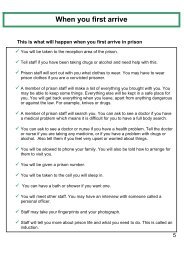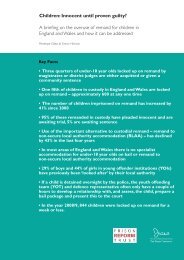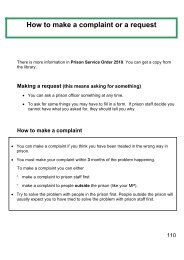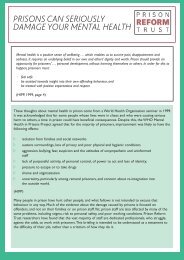BROMLEY BRIEFINGS PRISON FACTFILE - Prison Reform Trust
BROMLEY BRIEFINGS PRISON FACTFILE - Prison Reform Trust
BROMLEY BRIEFINGS PRISON FACTFILE - Prison Reform Trust
Create successful ePaper yourself
Turn your PDF publications into a flip-book with our unique Google optimized e-Paper software.
Drug use amongst prisoners in custody isreported to be high. A recent Home Officestudy found that four out ten prisoners saidthey had used drugs at least once whilst intheir current prison, a quarter had used inthe past month and 16% in the past week.Cannabis and opiates were the drugs mostoften used. Almost a third of prisonersreported cannabis use and one in five opiateuse in their current prison, while 9% and 10%respectively reported using these drugs in thepast week. 248All prisoners are subject to randommandatory drug tests. 9% of the prisonpopulation tested positive from randommandatory drug tests compared with over20% 10 years ago. 249 But a recent HomeOffice study found that ‘mandatory drugtesting results generally underestimate thelevel of drug misuse as reported byprisoners’. 250Concerns have been raised about thequality of detoxification, especially forprisoners who have been dependent oncrack cocaine. 251 Research has found thatarrangements for detoxification appear tovary considerably between differentprisons. 252Nine out of ten young adult prisoners saythey used drugs prior to imprisonment butonly one in three young offender institutionsprovide intensive drug treatmentprogrammes. 254Transfers between prisons due toovercrowding often disrupt drug treatment.Recent research found that a third of prisonswere unlikely to be able to continue thetreatment of prisoners transferred to them. 255Drug use on release from prison is very high.One survey of prisoners who had mostly servedshort sentences and had used drugs in the 12months before imprisonment, found that 77%admitted taking illegal drugs since release. 256The Social Exclusion Unit found that the‘chances of continuing drugs programmes andsupport on release are very slim’ andconcluded,‘prisoners are often viewed as ‘newcases’ when they are released and have tojoin the back of the queue’. 257 The HomeOffice has no comprehensive tracking systems inplace to monitor access to community drugtreatment but is currently developing work in thisarea. 258In 2006-07, 7,675 drug treatmentcompletions were delivered. Thisrepresented an achievement of 29.6% inexcess of target. 253248. Singleton et al (2005) The impact and effectiveness of Mandatory Drugs Tests in prison, Findings 223 London: Home Office249. <strong>Prison</strong> Service, Annual Report and Accounts April 2006 – March 2007, 17 July 2007, p. 26250. Singleton et al (2005) The impact and effectiveness of Mandatory Drugs Tests in prison, London: Home Office251. HM Inspectorates of <strong>Prison</strong>s and Probation (2001) Through the <strong>Prison</strong> Gate: Thematic Review by HM Inspectorates of <strong>Prison</strong>s and Probation, London: StationeryOffice252. Home Office (2003) Differential substance misuse, treatment needs of women, ethnic minorities and young offenders in prison: prevalence of substancemisuse and treatment needs, Home Office Online Report 33/03253. HM <strong>Prison</strong> Service, Annual Report and Accounts April 2006 – March 2007, 17 July 2007, p. 23254. Social Exclusion Unit (2002) Reducing re-offending by ex-prisoners, London: Social Exclusion Unit255. National Audit Office (2002) Reducing re-offending, London: National Audit Office256. Social Exclusion Unit (2002) Reducing re-offending by ex-prisoners, London: Social Exclusion Unit257. Ibid.258. Government reply to the first report from the Home Affairs Committee on the Rehabilitation of <strong>Prison</strong>ers Session 2004-2005, HC193www.prisonreformtrust.org.uk 31
















